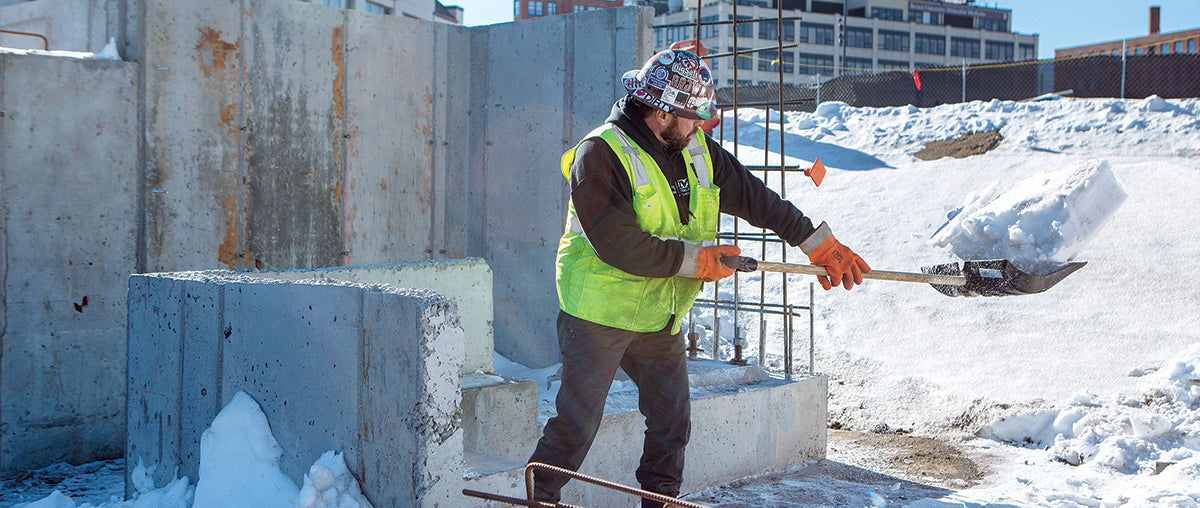Working outside in the winter can be dangerous, and construction workers who must brave the cold face occupational hazards like frostbite and hypothermia. Is your team ready to work in winter? This article provides an introduction to winter hazards and what you can do to keep yourself and your team safe when working in the cold.
Environmental conditions
There are four main environmental conditions that frequently lead to winter illness – low temperatures, wind, dampness, and cold water. As we have all experienced, when weather is cold, our senses tend to weaken in our fingers and toes - especially when doing construction work, this is extremely dangerous. Proper gloves, socks and shoes are essential. Windchill and humidity can make a bearable temperature feel like bitter cold, so it is important to notice these details before heading to the workplace. Lastly, cold water is a hazard to be wary of. Wet clothes in freezing temperatures will become icy and won’t protect you from the cold. It is important to stay as dry as possible when working outside in low temperatures.
A quick look at the weather forecast will give you the information you need to dress appropriately for work. Exposed skin begins freezing at only 28º F, so if temperatures are expected to be at or below this, you should ensure your entire body is protected with warm socks, water resistant boots, long pants, gloves, layered jackets, and a hardhat liner or balaclava to protect your neck and face.
Major Health Hazards
Hypothermia and frostbite are two major concerns to consider when working outdoors in cold weather. Between 1979 and 1995, an average of 723 Americans died each year as the result of hypothermia. Hypothermia is effectively the body freezing and shutting down. Symptoms include fatigue, nausea, confusion, light-headedness and profuse sweating. Without medical treatment the victim can lose consciousness and die. If you notice yourself or a fellow worker feeling these symptoms, stop work immediately and tell your supervisor.
Frostbite usually begins in fingers and toes, but deep frostbite can spread extensively in the body which can cause blood clots and gangrene. The best way to prevent frostbite is to dress in appropriately warm protective clothing. Thermal gloves and thick soled boots are a very important to safely work outside. If you need warmer gear, contact your supervisor and request an upgrade – your employer will know that your health is worth the investment.
Risk Factors
Major risk factors for cold-related problems include the following:
- Wearing inadequate or wet clothing increasing the effects of cold on the body
- Taking certain drugs or medications such as alcohol, nicotine, caffeine, and medication; they inhibit the body’s response to the cold and impair judgment
- Having a cold or certain diseases like diabetes, heart, vascular, and thyroid problems may make a person more susceptible to the winter elements.
- Becoming exhausted or immobilized, especially due to injury or entrapment, may speed up the effects of cold weather.
Ten tips for working in winter weather:
- Wear the right gloves for the work you are doing. Gloves should have enough insulation to keep you warm and prevent frostbite, but be thin enough so you can feel what you are doing if you are manipulating controls or tools. Gloves that are too thick can make your hands and wrists work too hard trying to hold on to objects, causing repetitive strain injury.
- Dress in layers of light-weight clothing. They will keep you warmer than a single heavy layer. Remove layers as necessary to prevent overheating and perspiration, which can lead to chills or hypothermia. Wet clothing is 20 times less warm than dry clothing.
- Wear a hat or hard hat liner. You’ll stay much warmer. As much as half of your body heat can go up in steam from the top of your bare head. Protect your ears from frostbite as well by wearing a hat, hard hat liner or earmuffs to cover your ears.
- Check your winter wardrobe for entanglement hazards like loose sleeves and dangling drawstrings and secure them before beginning work. Scarfs or mufflers may help keep your neck warm, but they can kill you if you are working near rotating machinery. Balaclavas and long hard hat liners are a better option.
- Use safety eyewear that doesn’t fog up in the cold. Anti-fog coatings are highly effective and can make a huge difference. If you have to keep taking off your safety eyewear because it fogs up, it isn't protecting you. Contact your supervisor if this is an issue to resolve the problem with better safety glasses.
- Inspect the soles of your winter footwear. Your shoes should have adequate tread to prevent slips and falls on wet or icy surfaces. For extremely slippery situations, you can attach YaxTrax or equivalent products to your footwear. Slow down when walking across slippery surfaces and be especially careful on ladders, platforms and stairways.
- Eat winter-weight meals. This does not mean a high fat diet, but one with enough calories and nutrients to give you the fuel you need. Whole grain toast or cereal is a great way to start the day.
- Get plenty of rest. Working in the cold and traveling to and from work in the winter takes lots of energy. Cold weather can strain your heart, even if you aren't overexerting yourself, so be sure to pace yourself when lifting heavy objects or shoveling snow.
- Pay attention to how much you are sweating. If you notice you are sweating more than usual, this could be a sign of hypothermia.
- Know where to go if you get too cold – a nearby coffee shop or onsite warming hut should be available to you in case of emergency. If you experience symptoms of hypothermia or frostbite, ask your supervisor for a break to warm your body up.

